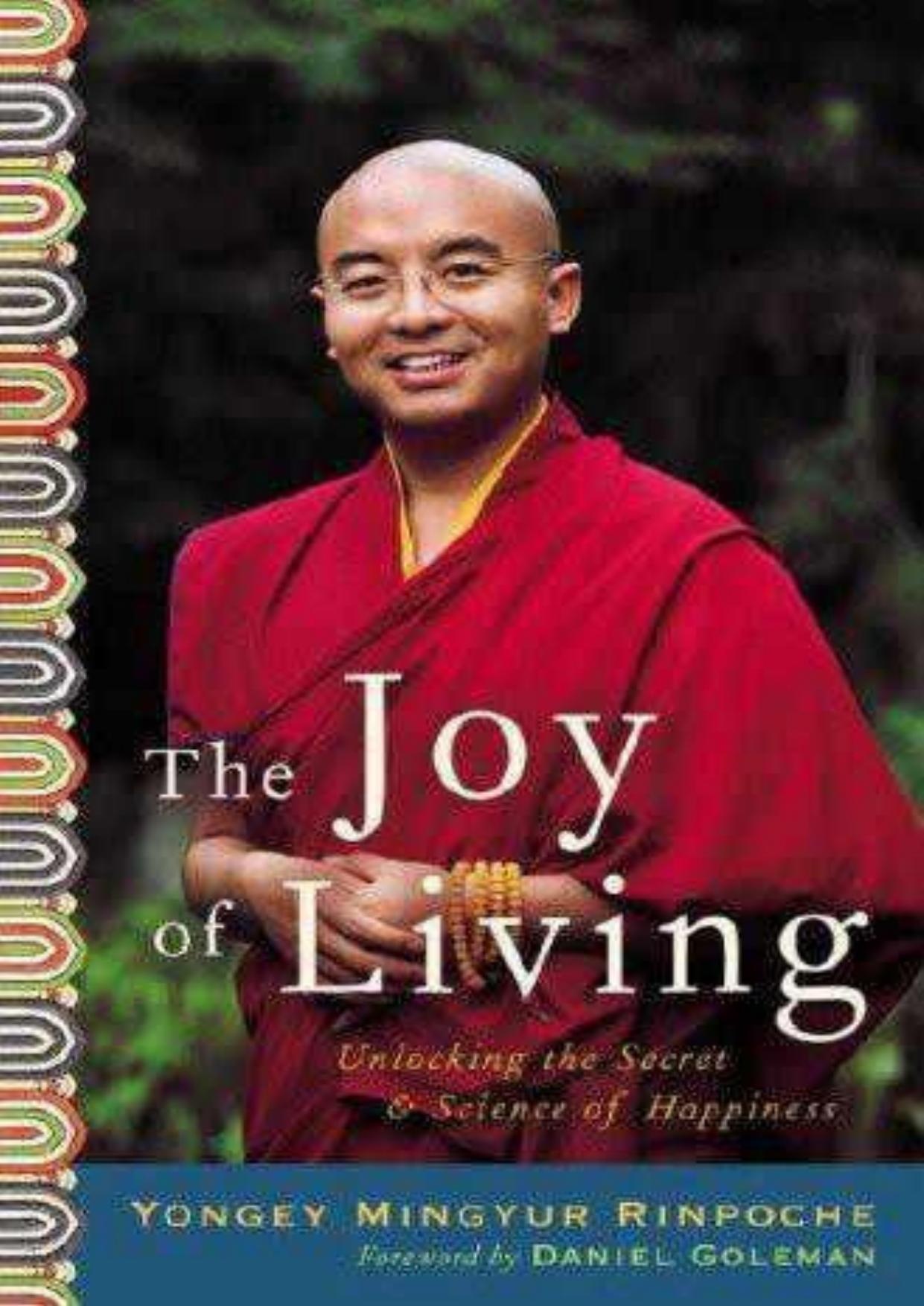The Joy of Living: Unlocking the Secret and Science of Happiness by Yongey Mingyur Rinpoche

Author:Yongey Mingyur Rinpoche [Rinpoche, Yongey Mingyur]
Language: eng
Format: epub, mobi, pdf
Tags: Life Sciences, Human Anatomy & Physiology, Science, Religion, Buddhism, Rituals & Practice
ISBN: 9780307346254
Publisher: Crown Publishing Group
Published: 2007-03-06T01:47:25+00:00
PHYSICAL POSTURE
Great wisdom abides in the body.
—The Hevajra Tantra, translated by Elizabeth M. Callahan
The Buddha taught that the body is the physical support for the mind. The relationship between them is like the relationship between a glass and the water it contains. If you set a glass down on the edge of a table or on top of something that isn’t flat, the water will shift around or possibly spill. But if you set the glass on a flat, stable surface, the water in it will remain perfectly still.
Similarly, the best way to allow the mind to come to rest is to create a stable physical posture. In his wisdom, the Buddha provided instructions for aligning the body in a balanced way that allows the mind to remain relaxed and alert at the same time. Over the years, this physical alignment has become known as the seven-point posture of Vairochana, an aspect of the Buddha that represents enlightened form.
The first point of the posture is to create a stable basis for the body, which means, if possible, crossing your legs so that each foot rests on the opposite thigh. If you can’t do this, you can just cross one foot on top of the opposite thigh, resting the other beneath the opposite thigh. If neither position is comfortable, you can simply cross your legs. You can even sit comfortably in a chair, with your feet resting evenly on the floor. The goal is to create a physical foundation that is simultaneously comfortable and stable. If you feel great pain in your legs, you won’t be able to rest your mind because you’ll be too preoccupied by the pain. That’s why there are so many options available concerning this first point.
The second point is to rest your hands in your lap just below your navel, with the back of one hand resting in the palm of the other. It doesn’t matter which hand is placed on top of the other, and you can switch their positions at any time during your practice—if, for instance, the covered palm gets hot after a long time. It’s also fine to simply lay your hands palm-down over your knees.
The third point is to allow a bit of a space between your upper arms and your torso. The classic Buddhist texts call this “holding your arms like a vulture,” which can easily be mistaken for stretching out your shoulder blades as if you were some sort of predatory bird.
In fact, one day, while I was teaching in Paris, I happened to be walking through a park when I saw a man sitting cross-legged on the ground, repeatedly flapping his shoulders forward and back. As I passed him, he recognized that I was a monk (the red robes are pretty much a giveaway), and asked me, “Do you meditate?”
“Yes,” I replied.
“Do you have any problems?” he asked.
“Not really,” I told him.
We stood for a moment smiling at each other—it was a nice, sunny day in Paris, after
Download
The Joy of Living: Unlocking the Secret and Science of Happiness by Yongey Mingyur Rinpoche.mobi
The Joy of Living: Unlocking the Secret and Science of Happiness by Yongey Mingyur Rinpoche.pdf
This site does not store any files on its server. We only index and link to content provided by other sites. Please contact the content providers to delete copyright contents if any and email us, we'll remove relevant links or contents immediately.
| Anatomy | Animals |
| Bacteriology | Biochemistry |
| Bioelectricity | Bioinformatics |
| Biology | Biophysics |
| Biotechnology | Botany |
| Ecology | Genetics |
| Paleontology | Plants |
| Taxonomic Classification | Zoology |
Sapiens: A Brief History of Humankind by Yuval Noah Harari(14254)
The Tidewater Tales by John Barth(12609)
Mastermind: How to Think Like Sherlock Holmes by Maria Konnikova(7229)
Do No Harm Stories of Life, Death and Brain Surgery by Henry Marsh(6891)
The Thirst by Nesbo Jo(6830)
Why We Sleep: Unlocking the Power of Sleep and Dreams by Matthew Walker(6618)
Life 3.0: Being Human in the Age of Artificial Intelligence by Tegmark Max(5476)
Sapiens by Yuval Noah Harari(5294)
The Longevity Diet by Valter Longo(5021)
The Body: A Guide for Occupants by Bill Bryson(4975)
The Rules Do Not Apply by Ariel Levy(4863)
The Immortal Life of Henrietta Lacks by Rebecca Skloot(4526)
Animal Frequency by Melissa Alvarez(4395)
Why We Sleep by Matthew Walker(4361)
The Hacking of the American Mind by Robert H. Lustig(4319)
Yoga Anatomy by Kaminoff Leslie(4307)
All Creatures Great and Small by James Herriot(4233)
Double Down (Diary of a Wimpy Kid Book 11) by Jeff Kinney(4208)
Embedded Programming with Modern C++ Cookbook by Igor Viarheichyk(4101)
